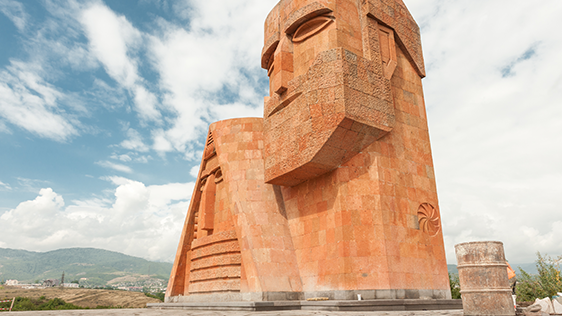Armenians and Azeris have been trading cross-border attacks and sniper fire since the beginning of the Karabakh conflict in 1988.
President Ilham Aliyev of Azerbaijan has made no secret of favoring a no-war, no-peace policy in the region to wear out Armenia, depopulate the country and pave the way for a takeover, not only of Karabakh but also Armenia.
Since an unofficial meeting between Armenian Prime Minister Nikol Pashinyan and Aliyev in Astana in October 2018, cross-border shootings had noticeably decreased.
However, a sudden burst of violence on the border on March 6 in the Ghazakh region, leaving one Azeri soldier dead and one Armenian soldier wounded, does not indicate a routine exchange of fire but rather a signal of a broader political development in the region. In particular, four days later, in another attack, one Armenian soldier died.
Read also
Although Armenia and Azerbaijan are not directly involved in the Syrian war, their respective associations with Russia and Turkey have led to fallout in the Caucasus.
When Turkey lost 32 soldiers in the Idlib conflict in Syria, with another 30 wounded, President Recep Tayyip Erdogan planned his reprisals very carefully. He simultaneously took a trip to Baku, with a large delegation, and on the other hand, appealed to the West, and in particular, to NATO. The West’s cool response to Erdogan’s plea opened the floodgates of immigrants in Europe, breaking a 2016 agreement with the European Union in which Turkey agreed to give a home to refugees fleeing Syria.
Recent reports from the European Union indicate that Europe is caving in to Erdogan’s bullying, promising more funds to Turkey, after a meek complaint that this is not the proper way to extract funds from the West.
The Erdogan delegation’s sudden visit to Baku in February and the provision of fresh military hardware to Azerbaijan was a warning to Moscow over Armenia’s head.
Another development in the region which coincided with Erdogan’s trip was the visit of Georgia’s Minister of Defense to Armenia to conclude some deals in their common defense. The Georgians have been growing weary recently with the increasing Turkish and Azeri influence in their country, and have finally tilted towards Armenia.
All the above developments were the ramifications of the major standoff between Russian President Vladimir Putin and Erdogan.
The latter’s arrogance had met the intransigence of Putin who had been expected in Istanbul on March 5 to resolve the carnage in Idlib. Flexing his power, Putin refused to budge and forced Erdogan to visit Moscow with a top-level delegation, including the ministers of foreign affairs, defense and economy.
After six hours of intense debate, during which time Putin and Erdogan avoided eye contact, they basically agreed to disagree. In fact, they only made some cosmetic changes to the Sochi agreement of October 2019. Russia insisted on continuing to fight groups which were labeled as terrorists by the United Nations. Turkey reserved the right to retaliate if its forces came under attack. A ceasefire was agreed upon, with the establishment of a 14-mile corridor under Russian and Turkish control. The losing side in this agreement was Syria, whose forces had been making headway in Idlib. President Bashar al-Assad of Syria has vowed to capture Idlib and move to the east to get rid of the mercenaries there on Turkish payroll.
The ceasefire, the tenuous agreement, the plans and determination of all the parties concerned have turned the region into a powder keg, ever further away from any prospect of peace.
The Russian-Turkish confrontation was continuing for a long time, with its potential fallout in the Caucasus. However, throughout those developments, politicians, the news and media in Armenia were almost deaf to the situation. The removal of seven judges from the benches of the Constitutional Court, the circus of insulting former presidents, no matter how much they deserved them, had become all-encompassing issues of life and death. Only the detonation of bombs in Ghazakh finally got through to the public that the region was heading toward a major unrest. The media, the pundits and news outlets have begun to focus on those global issues. Armenia finally realized that Karabakh was on the global map to be used by Turkey as Russia’s pressure point.
Although Pashinyan carefully calibrates his foreign policy, the media is enjoying an orgy of Russia bashing.
It is hard to guess how many politicians realize the outcome of that anti-Russian rhetoric.
In those tense moments, Armenians expect to find friends in the global news media and one of the columnists who normally plays fair has been Thomas de Waal, who this time has come up in a disappointing statement. In an article titled “Time for an Armenia-Azerbaijan History Ceasefire,” he has created parity between the Sumgait pogroms and the Khojali deaths.
The first one was an organized carnage against unarmed civilians, resulting in the expulsion of 350,000 from Azerbaijan; the latter was the sad result of war casualties.
In a typical Western condescending tone, treating all people outside the west as barbarians, he questions the veracity of the historic facts presented by both sides, rather than doing due diligence to sort out fact from fiction.
A war is raging in Syria, the fallout from which is reaching Armenia.
A war of words with equal intensity has taken over the news media. The euphoria after the Velvet Revolution should not lead Armenia to complacency. Our external problems are more pressing than the internal.
The media and the politicians would be doing a disservice to Armenia if they fail to make a distinction at this time and draw the wrong conclusion.



















































